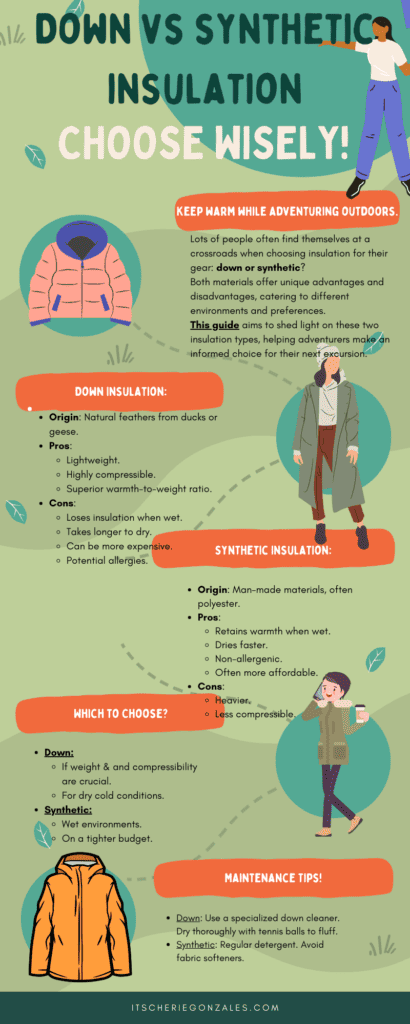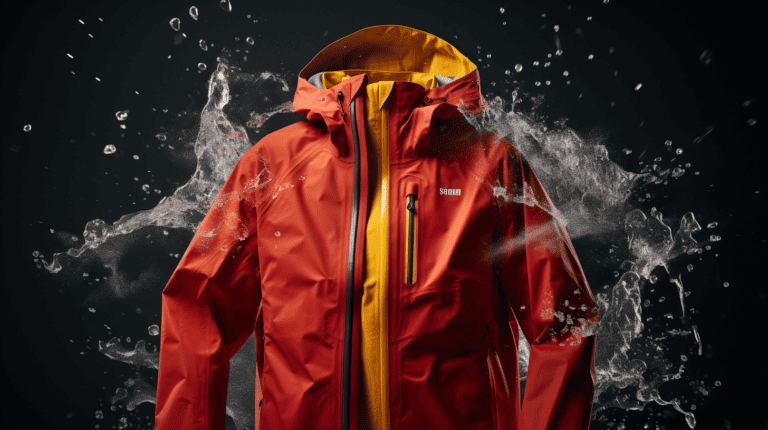Beginner’s Guide to Down and Synthetic Insulation: What’s the Difference?

Welcome to this comprehensive beginner’s guide to understanding the differences between down and synthetic insulation. As an avid outdoor enthusiast, I aim to share with you not just the technical aspects, but also the practical implications of choosing between these two types of insulation for your outdoor adventures.
This guide is born out of a genuine passion for helping fellow outdoor lovers make informed decisions about their gear, based on real experiences and reliable information. Whether you’re gearing up for a ski trip, a winter hike, or simply looking to expand your knowledge about outdoor clothing, this guide is crafted to provide you with valuable insights, exploring the differences and benefits of down and synthetic insulation, ensuring you are well-equipped for your next cold-weather endeavor.
Key Takeaways

Understanding Insulation: An Overview
Insulation plays a vital role in outdoor gear, as it helps regulate body temperature by trapping warm air close to the body. This insulation layer creates a barrier against the cold, keeping you warm and comfortable during any outdoor activity.
When it comes to outdoor gear, insulation serves as a critical component, playing a key role in maintaining comfort and protection in cold temperatures. Whether it’s a winter jacket, sleeping bag, or gloves, the insulation provides the necessary warmth to keep you comfortable in chilly conditions.
The Importance of Insulation in Outdoor Gear
Imagine yourself on a winter hiking trip, surrounded by snow-covered mountains and a crisp, cold breeze. Without proper insulation in your gear, this picturesque adventure could quickly turn into a freezing and uncomfortable experience. That’s where insulation comes in.
Insulation acts as a shield against the harsh elements, keeping your body warm and protected. It works by trapping air, which is an excellent insulator, within its fibers. This trapped air creates a layer of warmth around your body, preventing the cold air from penetrating and stealing away your precious heat.
Not only does insulation keep you warm, but it also helps regulate your body temperature. When you engage in physical activities, your body generates heat, causing you to sweat. Without proper insulation, this moisture can quickly cool down and make you feel cold and damp. However, with the right insulation, the moisture is wicked away from your body, keeping you dry and comfortable.
Different Types of Insulation Materials
Now that we understand the importance of insulation in outdoor gear, let’s explore the different types of insulation materials commonly used.
Down Insulation: Down insulation is known for its exceptional warmth-to-weight ratio. It is made from the soft and fluffy feathers found beneath the outer feathers of ducks and geese. These feathers create tiny air pockets that trap heat effectively, providing excellent insulation. Down insulation is highly compressible, making it ideal for lightweight and packable gear.
Synthetic Insulation: Synthetic insulation, on the other hand, is made from synthetic fibers such as polyester. It is designed to mimic the properties of down insulation while offering some advantages. Synthetic insulation performs better when wet, as it retains its insulating properties even when damp. It is also hypoallergenic and easier to clean and maintain compared to down insulation.
Both down and synthetic insulation have their strengths and weaknesses, and the choice between the two depends on personal preferences, budget, and specific outdoor activities. Some people prefer the warmth and compressibility of down insulation, while others opt for the durability and moisture resistance of synthetic insulation.
When selecting outdoor gear, it’s essential to consider the insulation type and its suitability for your intended use. Whether you’re planning a winter camping trip, a ski adventure, or simply braving the cold for a morning jog, having the right insulation in your gear can make all the difference in your comfort and enjoyment.
Down Insulation Explained
Let’s first delve into down insulation, which is widely regarded for its superior warmth and compressibility.
When it comes to outdoor gear, insulation is a crucial factor to consider. Whether you’re hiking in the mountains or camping in the wilderness, staying warm is essential for a comfortable and enjoyable experience. And that’s where down insulation comes into play.
What is Down Insulation?
Down insulation is sourced from the soft and fluffy layer found beneath the feathers of ducks and geese. It consists of fine filaments that create air pockets, trapping warmth effectively, and providing excellent heat retention.
But what makes down insulation so remarkable? It’s the natural properties of down that set it apart. The filaments in down clusters have a three-dimensional structure, allowing them to trap warm air efficiently. This means that even with a relatively small amount of down, you can experience exceptional warmth.
Furthermore, down insulation is incredibly lightweight and compressible. It can be compressed into a small space, making it ideal for backpacking and other outdoor activities where space is limited. Its ability to regain its loft after compression is another advantage, ensuring that it retains its insulating properties even after being packed tightly.
Pros and Cons of Down Insulation
Down insulation is renowned for its exceptional warmth-to-weight ratio, offering unparalleled insulation without adding significant bulk. This makes it a top choice for backcountry skiers and winter trekkers who need to minimize their load. Not only is down insulation incredibly lightweight and compressible, fitting easily into a backpack, but it also excels in cold, dry conditions, providing superior warmth retention.
In addition to its warmth and compressibility, down insulation is also highly durable. With proper care, it can last for many years, making it a worthwhile investment for those who frequently engage in outdoor activities.
However, it’s crucial to consider its limitations, especially its performance in wet conditions. Down tends to lose its insulating properties when damp, as the feathers clump together and lose their loft. This can be a significant drawback in snowy or humid environments, where retaining warmth despite moisture is critical. Modern advancements, such as water-resistant down treated with a Durable Water Repellent (DWR), have mitigated this to some extent, but they don’t eliminate the problem. Also, down requires careful maintenance to preserve its longevity, needing proper storage and occasional cleaning with specific methods to maintain its loft and effectiveness.
From my personal experience in using down insulation, I’ve found its performance unparalleled in dry, frosty conditions. Its ability to provide substantial warmth while being almost feather-light is a major advantage, particularly on long ski tours where every ounce counts. I recommend down insulation for those who prioritize warmth and lightness and are mainly exploring drier winter landscapes
Best Uses for Down Insulation
Down insulation is highly recommended for ultralight backpacking and activities in dry and cold climates. Its unmatched warmth and packability make it a top choice for adventurers looking to minimize weight without sacrificing warmth.
Whether you’re embarking on a multi-day trek through snow-covered mountains or spending a chilly night under the stars, down insulation will keep you cozy and comfortable. Its ability to provide exceptional warmth while taking up minimal space in your backpack is a game-changer for outdoor enthusiasts.
So, next time you’re planning an outdoor adventure, consider the benefits of down insulation. Its natural warmth, lightweight design, and durability make it an excellent choice for all your cold-weather escapades.

Synthetic Insulation
In contrast to down insulation, synthetic insulation is made from polyester fibers designed to mimic the insulating qualities of natural down.
When it comes to choosing the right insulation for your outdoor adventures, understanding the differences between synthetic and down insulation is crucial. While down insulation is known for its exceptional warmth-to-weight ratio, synthetic insulation offers its own set of advantages that make it a popular choice among outdoor enthusiasts.
What is Synthetic Insulation?
Synthetic insulation is created by intertwining polyester fibers, forming air pockets that trap warmth. Unlike down insulation, synthetic insulation retains its insulating properties even when wet, making it suitable for various weather conditions.
But how does synthetic insulation achieve this remarkable feat? The secret lies in its ability to repel water. The polyester fibers used in synthetic insulation are designed to resist moisture, ensuring that the insulation remains effective even in damp or wet environments. This is a game-changer for outdoor activities where exposure to rain or snow is inevitable.
Advantages and Disadvantages of Synthetic Insulation
One clear advantage of synthetic insulation is its ability to maintain warmth when wet. Even if moisture seeps into your gear, synthetic insulation still works effectively, making it a reliable choice for wet or damp environments.
Furthermore, synthetic insulation dries quickly, allowing you to continue your adventures without being weighed down by heavy, waterlogged gear. This quick-drying property is especially beneficial for multi-day trips where you may not have the luxury of waiting for your gear to dry.
However, synthetic insulation has a relatively higher weight compared to down insulation, which can impact the overall weight and packability of your gear. If you’re an ultralight backpacker or someone who prioritizes minimizing weight, down insulation might be a more suitable option for you.
Additionally, synthetic insulation may not compress as well as down insulation, which can affect the packability of your gear. If space-saving is a top priority, you might need to consider the trade-off between compressibility and the advantages of synthetic insulation.
Ideal Conditions for Synthetic Insulation
Synthetic insulation is ideal for activities where exposure to moisture is likely, such as hiking in rainy or humid environments. Its ability to retain warmth even when wet provides peace of mind, allowing you to focus on enjoying your outdoor experience without worrying about the weather.
Moreover, synthetic insulation is an excellent choice for those who prefer cruelty-free options. As synthetic insulation is made entirely from polyester fibers, it does not use any animal products, making it a compassionate alternative for individuals who prioritize ethical considerations in their gear choices.
Whether you’re embarking on a wet and rainy adventure or simply prefer a cruelty-free insulation option, synthetic insulation has proven its worth in the outdoor community. With its ability to retain warmth even when wet and its versatility in various weather conditions, it’s no wonder why synthetic insulation has become a staple in outdoor gear.
Comparing Down and Synthetic Insulation
Now that we’ve explored the properties of down and synthetic insulation, let’s delve deeper into their key factors and discover more about their unique characteristics.
Warmth and Weight Comparison
When it comes to warmth, down insulation offers unparalleled performance for its weight. The natural loft of down feathers creates countless tiny air pockets that trap heat, providing exceptional warmth without significantly increasing the overall weight of your gear. This makes down insulation ideal for activities where weight is a crucial factor, such as backpacking and mountaineering.
On the other hand, while synthetic insulation may not offer the same warmth-to-weight ratio as down, it is still effective and advantageous when it comes to wet conditions. Synthetic fibers, such as polyester, are designed to retain their insulating properties even when damp. This makes synthetic insulation a reliable choice for activities in humid or rainy environments, where moisture resistance is essential.
Durability and Maintenance
In terms of durability, down insulation requires more care and maintenance. It is essential to keep it dry and fluffed to maintain its loft and insulation properties. Down feathers can lose their loft when exposed to moisture, which diminishes their ability to trap heat effectively. Additionally, down insulation can be more susceptible to damage from compression, so proper storage and handling are crucial to prolong its lifespan.
Synthetic insulation, on the other hand, is more resistant to compression and easier to maintain. Synthetic fibers are designed to bounce back after being compressed, allowing the insulation to retain its loft and insulating properties for a longer period. This makes synthetic insulation a practical choice for gear that will be subjected to rough handling or frequent use.
Cost Differences
Lastly, cost can be a factor to consider when choosing between down and synthetic insulation. Down insulation is generally higher in price due to its superior warmth-to-weight ratio and premium quality. The meticulous process of sourcing, cleaning, and processing down feathers contributes to its higher cost. However, investing in down insulation can be seen as a long-term investment in high-performance gear.
Synthetic insulation, being more affordable, provides a reliable and budget-friendly option. The synthetic fibers used in insulation are readily available and can be produced at a lower cost, making synthetic insulation a popular choice for those on a tighter budget or who prioritize cost-effectiveness.
Ultimately, the choice between down and synthetic insulation depends on your specific needs and preferences. Consider factors such as the climate you’ll be in, the desired warmth-to-weight ratio, and your budget. Weighing these factors will help you make an informed decision when selecting insulation for your outdoor gear.
FAQ
Is down better than synthetic?
Down offers superior warmth-to-weight but performs poorly when wet. Synthetic insulation is less warm for its weight but retains warmth better when damp and is generally cheaper. The choice between down and synthetic depends on the specific needs and conditions.
What is synthetic down?
Synthetic down is a man-made material designed to mimic the properties of natural down feathers. It’s typically made from polyester fibers that are structured to replicate down’s loft and insulating capabilities. Unlike natural down, synthetic down retains warmth when wet and dries faster, but it’s usually bulkier and less efficient at insulation by weight.
Are down coats the warmest?
Down coats are among the warmest for their weight, due to the exceptional insulating properties of down feathers. The warmth of a down coat is often determined by its fill power, with higher fill power indicating greater insulation capabilities. However, in wet conditions, down loses its insulating properties, whereas some other materials like synthetic insulation still perform. For dry, cold conditions, high-quality down coats are hard to beat in terms of warmth-to-weight ratio. But in damp or wet conditions, synthetic or other types of insulation may be preferable.






